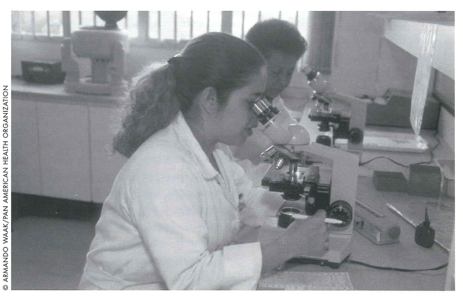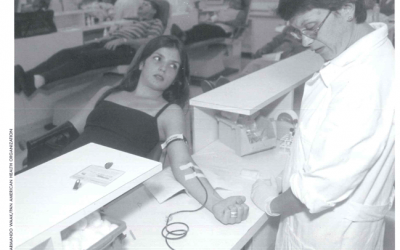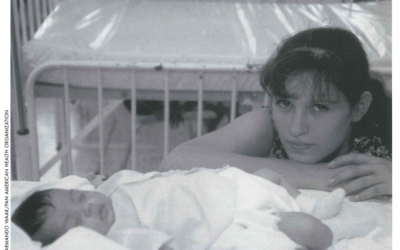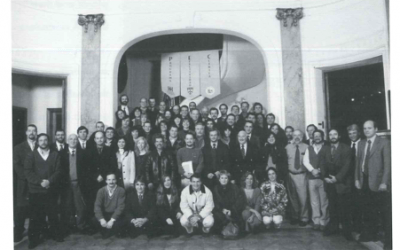Emerging Infections
Dengue and Beyond

Despite vaccines, some infectious dis- eases are alive and well, even thriving, and are changing in ways that had not been anticipated.
We all know infectious diseases from personal experience. Starting in childhood we typically experience influenza, chickenpox, strep infections of the throat, viruses that cause upper respiratory infections, and miscellaneous skin infections. We expect that most serious infections can be prevented with vaccines, treated with antibiotics, or will retreat, given time. In the middle part of this century, the success with vaccines and drugs led some to speculate about the end of infectious diseases as a major problem for humans. Those speculations were shortsighted and wrong. Recent events have made it clear that infectious diseases are alive and well, even thriving, and are changing in ways that had not been expected.
Beginning in the early 1990s a group of faculty at the Harvard School of Public Health (HSPH) began regular discussions to try to understand why we were seeing accelerated changes in infectious diseases and seemingly unexpected events. We organized a 1993 workshop at Woods Hole that to the publication of a book (Disease in Evolution: Global Changes and Emergence of Infectious Diseases, New York Academy of Sciences, 1994). A second, larger meeting (Emerging Infections: Origins, Ecology and Prevention) at HSPH in 1997 supported in part by DRCLAS drew international participation, including several participants from Latin America. In both meetings, disease examples from Latin America had a prominent role.
Several infectious diseases have had dramatic impact in Latin America in the last decade outbreaks of cholera, spreading of AIDS, movement of leishmaniasis into new areas, including urban areas, massive epidemics of dengue fever, outbreaks of leptospirosis, increases in multidrug resistant tuberculosis, appearance of newly recognized hantaviruses and hemorrhagic fever viruses, among others. Many have had major economic repercussions.
Changes in several of these infectious reflect population size, mobility, density, vulnerability and changes in the environment and land use. Through specific disease examples, I will explore the interactions between social, economic, demographic, environmental circumstances and infections. Infectious diseases are dynamic and can be expected to continue to change in the future.
Dengue fever, also known as breakbone fever, is caused by a virus carried from one human to another by a mosquito, usually Aedes aegypti. A first infection with a dengue virus typically causes fever and a flu-like illness. In contrast to many infections that are followed by lifelong immunity to that disease, infection with one type of dengue virus primes a person for more severe illness if infected in the future with a different strain of dengue virus. Four different types (serotypes) of dengue virus exist, numbered 1-4. A second infection is about 100-fold more likely to lead to one of the serious complications, dengue shock syndrome (DSS) or dengue hemorrhagic fever (DHF), which can be fatal.
Dengue fever outbreaks probably first occurred in the Americas centuries ago. There has been a major increase in the burden of dengue disease (increase in number of cases and expansion into new geographic areas) in Latin America in the last two decades. Dengue sickens local populations and spills over into visitors to the region.
Humans are the only important host for the dengue virus; infected humans, who carry the virus in their blood, transport the virus from one geographic region to another. If a mosquito competent to transmit dengue virus takes a blood meal from a human infected with dengue virus, it can spread the infection to other humans. Aedes aegypti, the most important mosquito vector for dengue, now infests large parts of urban and rural Latin America and the Caribbean. The habits and habitats of Aedes aegypti make it well suited to sustain dengue fever outbreaks. It is highly domesticated, breeding in and around houses. It lays eggs in flowerpots, discarded plastic containers, used automobile tires, buckets, and any trash items that collect water. The adult mosquito prefers to rest indoors and to feed during daylight hours on humans, its preferred host. After a mosquito ingests virus by biting an infected human, the virus replicates within the salivary glands and the mosquito becomes infectious (capable of transmitting the virus) after 8-10 days and remains infectious for life. If the female mosquito is interrupted while feeding, she may bite (and infect) multiple other humans.
Aedes aegypti also transmits the viral infection, yellow fever, which, although often fatal, can be prevented with a highly effective vaccine. In the 1940s, 1950s, and 1960s the Pan American Health Organization (PAHO) carried out Aedes aegypti mosquito eradication campaigns to prevent urban epidemics of yellow fever. The mosquito was eradicated from large parts of Latin America. Since the program’s discontinuation in the early 1970s, the mosquito has reinfested most of the region. This has coincided with increasing numbers of epidemics of dengue fever, infecting millions of people. Countries free of dengue for decades had severe epidemics in the 1980s. DHF/DSS emerged as a major public health problem in Latin America in the late 1980s and continues unabated today.
For example, in Brazil, more than 500,000 dengue cases were reported in 1998 and Aedes aegypti infested all important urban centers in Brazil. As of 1999 Aedes aegypti was present in all states, and dengue transmission had been reported in 22 of 27 states. Dengue serotype 1 has been present since 1986 and serotype 2 since 1990, setting the stage for widespread DHF/DSS if new serotypes of dengue are introduced. As of early 1999 all four serotypes had been documented in Mexico, Puerto Rico, Barbados, and Guatemala.
Two other factors travel and urbanization – have contributed to the appearance and spread of dengue virus. More people live in urban areas than ever before. In South America, 78% of the population lived in urban areas in 1995; this is projected to increase to 88% by 2025. Much of the growth of cities is unregulated and huge slums surround some cities, areas with poor housing, inadequate waste disposal, and lack of clean water an ideal environment for breeding of mosquito vectors (and presence of rodents, relevant for other diseases). Poor housing and absence of screens increases the potential contact between mosquitos and humans. It is estimated that a population size between 150,000 and 1 million is needed to sustain the circulation of a dengue virus and to increase the risk of severe forms of dengue fever. Recent studies also point to another reason to be concerned about population size. Over the past two centuries the number of dengue lineages has been increasing roughly in parallel with the size of the human population. Scientists have suggested that a larger human population in which the virus replicates allows increased opportunities for viral evolution and enhances the potential for the appearance of more virulent strains.
Global travel continues to increase. Air traffic volume has increased about 7% per year for the past 20 years and as of the mid 1995s about 5000 airports had scheduled worldwide service. This massive movement of the human population links all major urban areas of the world. Speed of travel means that a person bitten by a mosquito carrying dengue in Bangkok can reach home in Brazil before symptoms of infection begin. Travelers carrying the dengue virus have transported it around the globe and introduced different serotypes into new areas where competent vectors exist. It is the co-circulation of more than one dengue serotype that sets the stage for severe disease.
When dengue epidemics occur in Latin America, the virus also infects travelers to the region. A sharp increase in dengue cases in the United States was reported in 1997 and 1998. In 1998 almost 40% of reported dengue cases in the US followed travel to the Caribbean. In 1997 and 1998 of the 122 imported cases for which the travel history was known, 88 reported recent travel to the Caribbean islands, Central or South America.
Poor housing and lack of vector control can increase the risk of exposure to dengue virus. Lack of access to good health care can lead to increased mortality from the severe forms of dengue fever (DHF/DSS). Mortality for cases of DHF exceeded 20% in some Latin American countries in 1998 but was less than 1% in others. Major epidemics sometimes overwhelm local health facilities.
Good laboratory support is essential to identify dengue infections and other diseases. This is important not only because knowledge of circulating viruses can inform public health interventions but also because many other diseases can resemble dengue fever. The following examples underscore the relevance of identifying the exact cause of disease and point to the critical role of laboratories.
In September 1989 an outbreak of severe hemorrhagic fever in Guanarito, Portuguesa State, Venezuela, was initially thought to be dengue hemorrhagic fever. When tests for dengue were negative, additional studies were performed. A new virus, an arenavirus designated Guanarito virus, was identified as causing the disease, now described as Venezuelan hemorrhagic fever. Between September 1989 and May 1995, 105 cases were reported, more than 30% fatal. Once identified, the virus’ origins and means of transmission could be investigated. Since other arenaviruses have rodent reservoirs, investigators searched for the virus among local rodents and found the same virus in the cotton rat and cane mouse. These rodents are chronically infected without symptoms but shed Guanarito virus in their urine and saliva for up to five months. Investigation revealed that the virus was an old virus, long present in rodents in the area, and perhaps causing occasional, unidentified infections in humans in the past. What had changed was that during the 10 years before the outbreak the human population in the area had more than doubled, mostly through migration. New agricultural lands had been developed. In addition to the local residents, large numbers of temporary agricultural workers entered the area during planting and harvesting seasons. Changes in land use provided more favorable habitats and food for the rodents, allowing rodent populations to increase significantly. Expansion of human and rodent populations increased the likelihood of human-rodent contact. Knowledge of the means of transmission of this infection has allowed more informed decisions about working the land in this area.
In late 1995 after heavy rains and flooding in a rural area north of Lake Managua, Nicaragua hundreds of people became ill with acute onset of fevers, chills, headaches, and muscle aches. By early November at least 150 people had been hospitalized and at least 13 had died from respiratory distress and lung hemorrhage. Initial tests focused on dengue and dengue hemorrhagic fever, but tests were negative for dengue. Further investigation revealed that the cause of the outbreak was leptospirosis, a bacterial infection that is treatable, if recognized. Wild and domestic animals can be chronically infected without symptoms and pass the leptospires in their urine, which can contaminate fresh water bodies. Humans become infected after contact with animal tissues or water or other material contaminated with infected animal urine. Water contact increased with flooding.
Large urban outbreak of leptospirosis occurred in Salvador, Brazil, in 1996. The largest peak of the epidemic came two weeks after severe local flooding. Because the leptospirosis epidemic overlapped with a dengue fever epidemic, 43% of patients with confirmed or probable leptospirosis were initially misdiagnosed as having dengue fever, delaying effective antibiotic treatment. Antibiotics can be lifesaving in leptospirosis whereas they have no effect on dengue fever, a viral infection. [Intravenous fluids and other supportive measures can markedly reduce mortality in patients with dengue hemorrhagic fever or dengue shock syndrome.] People living in favelas (slums where 47% of housing units have open sewage systems) had a relative risk of 4.0 for acquiring severe leptospirosis, compared with residents of other districts. Rodents often carry leptospirosis and those infected were more likely to report rodent contact.
Leptospirosis increased substantially in Puerto Rico after flooding from the 1996 hurricane. In the US, nine of 26 rafters became ill after a white water rafting trip in Costa Rica. Leptospirosis was confirmed. They had rafted on flooded rivers sometimes ingesting river water or falling into the river. Sometimes travelers can be a sentinel population that gives insight to diseases being transmitted locally. Travelers returning to the US often have access to diagnostic testing that may be unavailable to local populations in many parts of Latin America.
Knowledge of demographic, climatic, and environmental changes that can place areas or specific populations at increased risk for infections and good surveillance, communication, and laboratory support can all help to reduce the impact of infectious diseases. Infectious diseases will continue to move and to evolve. Understanding the reasons for change requires knowledge from a range of disciplines, including ecology, entomology, epidemiology, infectious diseases, population biology, international health, climate and environmental sciences.
Fall 2000
Mary E. Wilson, MD is Chief of Infectious Diseases at Mount Auburn Hospital, Cambridge, and is Associate Professor of Medicine at Harvard Medical School and Associate Professor of Population and International Health, Harvard School of Public Health. She has worked at the Albert Schweitzer Hospital in Haiti and served on the Academic Advisory Committee for the National Institute of Public Health in Mexico. Her main academic interests include emerging infections, travel medicine, vaccines, and tuberculosis.
Related Articles
Safe Blood for Transfusion
José Oscar Cotto López has donated 140 pints of blood since 1966. The 53-year old resident of San Salvador, El Salvador, does so because he believes it is an expression of love. “We must be…
Reproductive Health
On a hot, dusty day in the middle of a long drought, I attended a day-long assembly convened by the Ministry of Health’s Reproductive Health and Family Planning Program in Chulucanas, the…
Program in Clinical Effectiveness
As a family physician, I’ve always been interested in primary care and also in the broader perspective of health care systems focusing both on the individual patients and on populations…




